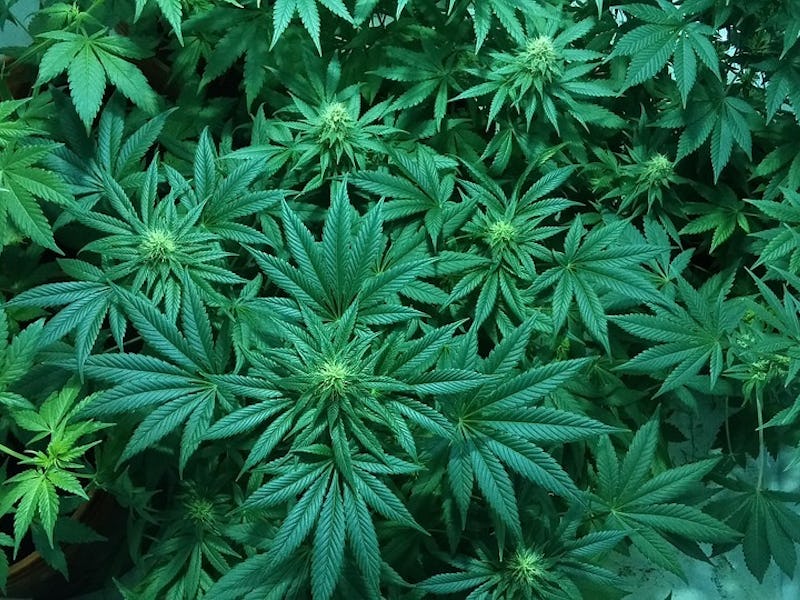The Biggest Mystery in Medical Pot Is the "Entourage Effect"
Should purity really be paramount?

In the 1980s, scientists offered volunteers pure, synthetic tetrahydrocannabinol, or THC — the most notorious, active ingredient in cannabis — in the form of the drug Marinol. The patients hated it.
This proved three things. First, what gives marijuana its characteristic high wasn’t just THC. Second, isolated chemicals don’t come close to rolling up a joint from marijuana leaves. And third: the “entourage effect” existed.
The term was coined by a team of organic chemists led by Israel’s “father of cannabis” Raphael Mechoulam in 1998, upon publishing their seminal paper on cannabinoid teamwork in the European Journal of Pharmacology. Since then, the entourage effect has been observed by researchers time and time again, calling into question the efforts of weed entrepreneurs to create distillates — nearly-pure versions of THC or CBD, isolated from most of marijuana’s 400+ other compounds, meant to be used in vapes or added to dabs and edibles in order to induce the cleanest, purest high.
It seems intuitive that concentrating the substance that produces the effects you want will give you more of those effects — there’s a reason “purity” is paramount in all realms of the drug world — but to what extent it should be concentrated remains a mystery because of the entourage effect.
Dragon Balls, made by X-Tracted Labs, contain 99 percent THC but may not optimize its synergistic effects with other compounds.
That hasn’t stopped brands like X-Tracted Labs or Organa Labs, which specialize in producing the extracts, from thriving; in a recent feature on the latter, Vice said its golden extracts, with levels of activated THC reaching 97 percent, were worth “three to five times the value of gold”. Likewise, companies like the German firm VTA, which produces the elaborate and expensive equipment required for distillation, are vying for exclusive distribution rights in the United States as legalization opens up the cannabis market. These distillation experts are pushing the science of the entourage effect to its limit, trying to find the bare minimum of other compounds that needs to be included in order to keep their synergy with THC intact.
It isn’t easy to find the right balance between a star cannabinoid and its supporting cast of compounds. Medical cannabis researcher and neurologist Dr. Ethan Russo, who in 2011 published a comprehensive review of the scientific literature on the entourage effect in the British Journal of Pharmacology and is currently working on cultivating new varieties of medical marijuana, is trying to figure that out. As he explained to Inverse, it makes sense to boost levels of one compound but not to get rid of all the others. “The ideal situation is selectively breeding to increase the concentrations of certain components, hopefully retaining the biochemical abundance of other components — retaining the entourage effect,” he says.
Cannabis distillates are added to edibles, oils, and dabs, but it's not clear how pure they should be for maximal effect.
But the entourage effect is a lot more complicated now than it was when Mechoulam first coined the term. Marijuana’s entourage has expanded from a small club of cannabinoids to a posse that includes hundreds of other substances — like flavor-making terpenoids, nitrogenous compounds, and hydrocarbons — that might contribute to the entourage effect. In his research on cannabis components for treating pain, psychiatric conditions, and especially cancer, he’s had the “revelation” that the terpenoids are an especially important cancer-fighting part of the cannabis entourage. Whether they work synergistically with the rest of marijuana’s compounds in the same way that THC does remains to be seen, but the science behind the entourage effect suggests that isolating them probably isn’t the best course of action.
The truth is, we just don’t know yet. And that’s a problem, both for scientists studying it and consumers. Russo is concerned about the severe dearth of information about the basic cannabinoids in the products that medical marijuana patients are buying. “A patient is lucky to have just a basic cannabinoid profile of the material that they’re anticipating buying,” he says. He’ll be adding to the industry’s limited knowledge base in August with a review in Advances in Pharmacology about all the cannabinoids for which we have pharmacological information and over 20 terpenoids.
While advances in cannabis biochemistry only seem to complicate our understanding of the entourage effect, they do seem to emphasize one overarching principle: Balance is key. The researchers behind Sativex, a cannabis-based multiple sclerosis drug, realized this when it observed that rougly equal parts THC and CBD were more effective than any one cannabinoid on its own, and it’s likely that future distillers struggling to achieve peak purity will ultimately find this guiding principle handy, too.